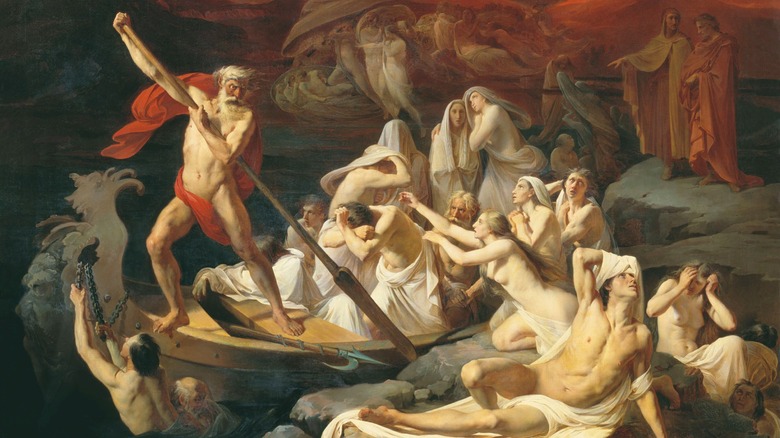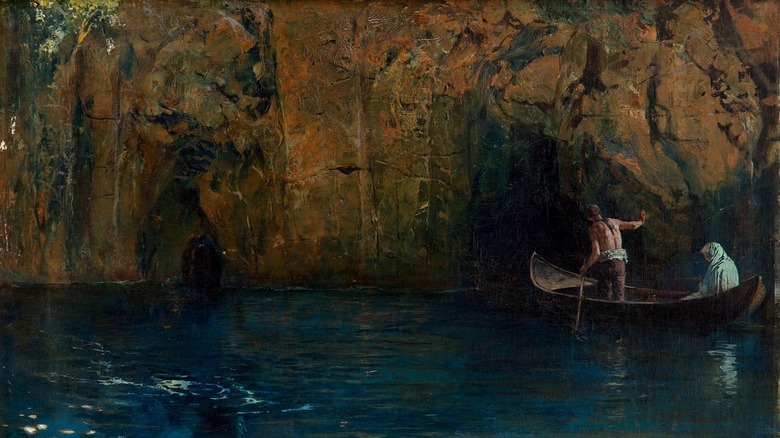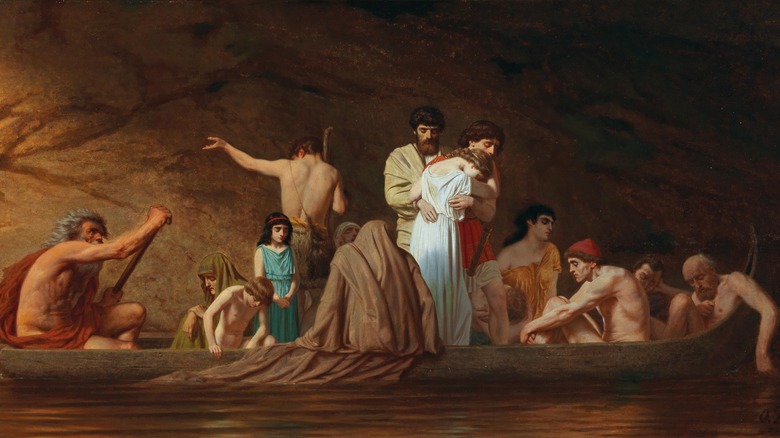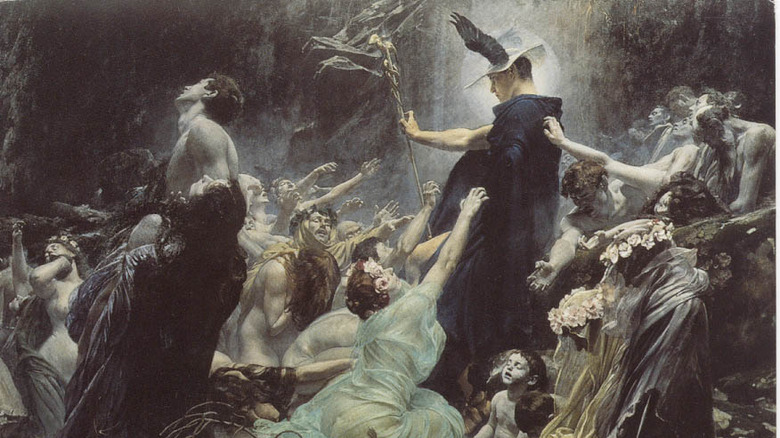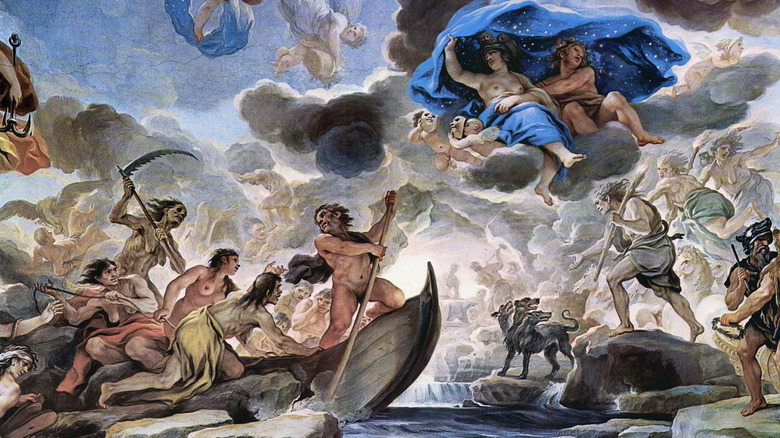The Five Rivers Of The Greek Underworld Explained
In the cosmology of Greek mythology, the Underworld, ruled by the god Hades, was one of the primary realms, together with the terrestrial world of the living and the celestial abode of the gods on Mount Olympus. While many modern religions might conceive of the afterlife as a non-physical dimension of the spirit, in the mythology of the ancient Greeks and Romans, the Underworld was a very real, physical place that you could go to (and with considerably greater difficulty, theoretically return from). As such, the Underworld is composed of topological features that you might find in the world of the living (via Greek Mythology). While the details of these features vary greatly over the centuries — from Homer's writing in the eighth century B.C.E. to mythographers like Pseudo-Apollodorus writing nearly a thousand years later — common features of the Underworld include a meadow of asphodel flowers, a region of punishment for big time sinners, and beautiful fields for the righteous.
One of the most common bits of infernal geography that is attested to as early as Homer and survives through the Classical world and makes its way into Dante's "Inferno" in the 14th century is the idea of the five rivers of the Underworld: the Styx, the Acheron, the Phlegethon, the Cocytus, and the Lethe, all of which have their own particular vibe and role and are associated (as all rivers were in Greek myth) with their own individual deity. Here's what you need to know about the rivers of Hades.
Styx, the river of hatred
Undoubtedly the most famous of the rivers of the Greek Underworld is the river Styx, possibly because its name is the shortest and easiest to pronounce. As Theoi explains, the name "Styx" derives from the Greek verb meaning "to hate," and the goddess of the river Styx is the daughter of the sea Titans Oceanus and Tethys, as well as the mother of such lower-tier deities as Nike (Victory), Zelos (Rivalry), and Kratos (Strength). The poet Hesiod says that Styx was an ardent supporter of Zeus in his battle against the Titans and brought all of her children to join his side. According to Hesiod, it was as thanks for this show of support that Zeus made the Olympian gods swear their eternal and unbreakable oaths on the waters of the river Styx.
As ThoughtCo records, the Styx is said to encircle the Underworld seven times and separate it from the world of the living, flowing as a branch of her father Oceanus, the river that surrounded the terrestrial world. The Roman poet Vergil depicts the Styx as the river over which the ferryman of the dead, Charon, ushers the souls of the dead (provided they have been properly buried) and on whose banks the three-headed dog Cerberus stands guard. Likewise, in later myth, it is the chilly waters of the Styx into which the nymph Thetis dips her infant son Achilles to grant him invulnerability (except, of course, for that spot on his heel where she held him).
Acheron, the river of pain
While the Styx is seen as the primary river of the dead these days, in much ancient literature, the river Acheron takes a more prominent role. As Theoi records, Virgil calls the Acheron the principal river of the Underworld and says that the others flow out of it. In much of antiquity, it was also thought to be the entrance to the Underworld (and was associated with a real river in Epirus in southeastern Europe). As such, it is not uncommon to see Acheron — and not the Styx — as the river across which Charon ferries the dead in sources such as Aeschylus, Euripides, and Plato. The name "Acheron" means "pain," and in addition to being a river, the name is also applied to a lake of the Underworld into which all the infernal rivers flow, though the lake is sometimes called "Acherusia" from the adjective form of the word "Acheron."
While the Acheron is one of the earliest mentioned rivers of Hades — it is alluded to in the Iliad and actually referred to by name in the Odyssey — it's only in later authors' work that the river god's lore gets beefed up a little. While the rivers of Hades were probably all originally the offspring of the great world-river Oceanus, later tradition says that Acheron was the son of the sun-god Helios and either the earth-mother Gaea or the grain goddess Demeter. He was condemned to become a river of the dead after using his waters to give refreshment to the Titans during their battle with Zeus and the Olympians.
Phlegethon, the river of fire
According to ThoughtCo, the river Phlegethon — also given as Pyriphlegethon in some sources — is the River of Fire, associated with the burning of funeral pyres and the punishment of the damned. The burning river leads into the realm of Tartarus, the section of the Underworld that serves as the place of torture for the worst sinners like Sisyphus and the prison for the Titans (after they lost their battle with Zeus). In the version of the kidnapping of Persephone written by Ovid in his poem "Metamorphoses," Persephone is tricked into eating the pomegranate seeds by Askalaphos (the son of the river god Acheron), whucg causes her to have to spend half the year in the Underworld. In anger, Persephone's mother, Demeter, threw water from the Phlegethon into Askalaphos' face, which transformed him into a screech owl.
Theoi shows that the Phlegethon is mentioned together with the other three principal rivers in the Odyssey, but it doesn't get a full explanation until Plato explains the Underworld in his dialogue "Phaedo." In his description, the Phlegethon flows into "a vast region burning with a great fire and makes a lake larger than our Mediterranean sea, boiling with water and mud." Likewise, Plato claims that the flames of the Phlegethon are the source of volcanic eruptions across the world, with the lava originating from the river's waters. Vergil describes the prison of Tartarus as being surrounded by the burning flames of Phlegethon like a moat of fire.
Cocytus, the river of wailing
The last of the four major rivers of the Underworld mentioned by Homer is the Cocytus, which is the River of Wailing (via ThoughtCo). According to Greek myth, the dead needed to be properly buried — with a coin to pay the toll for Charon's ferry — in order to be permitted into the land of the dead. Otherwise, their souls would be forced to wander on the threshold of the House of Hades, never allowed to receive their proper rest. Those who were denied admission into the Underworld would stand on the banks of the Cocytus and bewail their eternal fate, hence the name of the river.
Theoi shows that the Cocytus was considered a branch of the Styx, which flows into the Acheron. Despite this scant description from Homer, Plato adds that the Cocytus encircles Tartarus and falls into it on the side opposite the Phlegethon, where it is specifically associated with the punishment of murderers. There is essentially no mythology surrounding the river god Cocytus, without even an explicit parentage being recorded. But it is notable, perhaps, that Cocytus was the father of the nymph Minthe, who — as Theoi explains — was basically the only real mistress of Hades. Persephone trampled her husband's lover underfoot in a jealous fit, and the nymph was transformed into the plant mint, which was named after her and forever sacred to Hades. The association between the two probably arises from the use of mint at funerals to cover up the smell of the dead.
Lethe, the river of oblivion
The fifth river of the Underworld is never mentioned by Homer, but is nonetheless probably better known than, say, Phlegethon or Cocytus, thanks to having a cooler gimmick and a shorter and easier to pronounce name: the river Lethe, also known as the River of Oblivion (in the sense of forgetfulness, not destruction). As ThoughtCo explains, new inhabitants of the realm of the dead would be made to drink from the Lethe in order to forget their mortal lives. The river Lethe is, in some instances, conflated with the minor goddess Lethe, the goddess of forgetfulness (as opposed to the goddess of the river itself), who is the daughter of Eris, the goddess of strife and discord. Some funeral inscriptions from the fifth century B.C.E. indicate that there was also a stream of Mnemosyne (memory) that would allow the dead to retain their memories.
According to Theoi, some sources place Lethe along the border between the gloomy general population of Hades and the Elysian Fields, which are the blessed resting place of the righteous. In his epic, the "Aeneid," Vergil explains that drinking from the river Lethe is a key step in reincarnation: Those souls that are destined to live again must first drink deep of the river of forgetfulness before returning to the world of the living to experience life freshly anew. In his book of agricultural poems, the "Georgics," Vergil says that poppies' soporific properties come from being steeped in the waters of Lethe.
